Scientific papers 2023 - Part B

Authors: Betul Onal Gunay
Paracentral acute middle maculopathy (PAMM) is a
structural optical coherence tomography (OCT) sign
secondary to ischemia in the intermediate and deep
retinal vascular network, characterized by hyper-reflectivity
in the inner nuclear layer (INL).
The aim of the authors is to demonstrate PAMM
development following uncomplicated cataract surgery,
possibly triggered by fasting and dehydration. They also
aim to emphasize the potential role of hyperbaric oxygen
therapy in treating PAMM.


Authors:
Ran Arieli
Pulmonary oxygen toxicity (POT) is a major risk in diving
while breathing hyperoxic gas and is also considered in
clinical hyperbaric oxygen treatment. The author shows
that the pulmonary oxygen toxicity index calculated by the
power equation
offers a better prediction
than other suggested approaches.

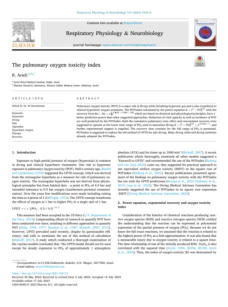

Authors:
Piotr H. Skarzynski, Aleksandra Kolodziejak, Elzbieta Gos,
Magdalena B. Skarzynska, Natalia Czajka, and
Henryk Skarzynski
This paper describes a retrospective clinical study that was
conducted to test the impact of hyperbaric oxygen
therapy in the treatment of patients with sudden
sensorineural hearing loss.


Authors:
Javed Iqbal, Abdullah Naeem, Kainat Jahangir, Yumna Ali,
Yusra Mashkoor, Ahmer Ashraf, Dalia Mehmood, Maria
Mehmood, and Lucke-Wold Brandon
Hyperbaric oxygen therapy (HBO2) aims to address
ischemia resulting from brain injury by subjecting patients
to an atmosphere that raises the concentration of inspired
oxygen (100% O2 at greater than 1 ATA). This results in
elevated levels of oxygen in the plasma, which in turn
boosts the delivery of oxygen for diffusion to the brain
tissue. This paper study the efficacy of hyperbaric oxygen
(HBO)-based modalities in brain injury


Authors: Arman Vahabi, Merve Mert, Huseyin Aytaç
Erdem, Ilgın Yıldırım Simsir, Meltem Isıkgoz
Tasbakan, and Anıl Murat Ozturk
The purpose of this study is to evaluate the side effects
associated with hyperbaric oxygen therapy and provide
recommendations to prevent them in patients with
diabetic foot ulcers.


Authors:
Clément Leveque, Simona Mrakic Sposta, Sigrid
Theunissen, Peter Germonpré, Kate Lambrechts,
Alessandra Vezzoli, Gerardo Bosco, Morgan Lévénez,
Pierre Lafère, François Guerrero, and Costantino Balestra
Hyperbaric oxygen therapy (HBOT) is a therapeutical
approach based on exposure to pure oxygen in an
augmented atmospheric pressure. Although it has been
used for years, the exact kinetics of the reactive oxygen
species (ROS) between different pressures of hyperbaric
oxygen exposure are still not clearly evidenced. In this
study, the metabolic responses of hyperbaric hyperoxia
exposures for 1 h at 1.4 and 2.5 ATA were investigated.


Authors:
Nicolas Vallée, Emmanuel Dugrenot, Anne-Virginie
Desruelle, Simone Richard, Stéphane Coupé, Céline
Ramdani, Régis Guieu, Jean-Jacques Risso, Sandrine
Gaillard, & François Guerrero
Decompression sickness (DCS) with neurological disorders
includes an inflammatory response which degenerates
slowly, even after the disappearance of the bubbles. There
is high inter-individual variability in terms of the
occurrence of DCS that could have been mastered by the
selection and then the breeding of DCS-resistant rats. The
authors hypothesized the selection of single-nucleotide
polymorphisms (SNPs) linked to autoimmunity operated
upon a generation of a DCS-resistant strain of rats.


Authors:
Costantino Balestra, Simona Mrakic-Sposta, and Fabio
Virgili
Nowadays, the therapeutic use of oxygen is not only
limited to restoring hypoxia, but several newly developed
approaches use oxygen not only as a “restoring agent”
but also as a potent stimulus. Salvagno et al. based their
review on the paradoxical response of the intermittent
shift between hyperoxic–normoxic exposure, which was
shown to enhance erythropoietin production and raise
hemoglobin levels with numerous different potential
applications in many fields of therapy as a new strategy for
surgical preconditioning aimed at frail patients and
prevention of postoperative anemia.


Authors:
Eyal Bar-Kochba, Alexander S. Iwaskiw, Jenna M. Dunn,
Jenna M. Dunn, Timothy P. Harrigan, and Constantine K.
Demetropoulos
This study presents an experimental characterization of
isolated human lung dynamics during simulated
exposureto underwater shock waves.
The authors found that the large acoustic impedance at
the surface of the lung severely attenuated transmission of
the shock wave into the lungs.


Authors:
Benjamin Simonnet, Romain Roffi, Henri Lehot, Jean
Morin, Arnaud Druelle, Lucille Daubresse, Pierre Louge,
Sébastien de Maistre, Emmanuel Gempp, Nicolas Vallee,
and Jean-Eric Blatteau
Spinal cord decompression sickness (scDCS) unfortunately
has a high rate of long-term sequelae. The purpose of this
study was to determine the best therapeutic management
in a hyperbaric center and, in particular, the influence of
hyperbaric treatment performed according to tables at 4
atm (Comex 30) or 2.8 atm abs (USNT5 or T6 equivalent).


Authors:
Owen J. ONeill, Anthony Haftel, Heather M. Murphy-
Lavoie
Despite all attempts to mitigate risk, tunnel compressed air
workers may still suffer the signs and symptoms of DCS
and a variety of other typical construction work-related
hazards.
This paper discusses discuss compressed air workers
performance in dry hyperbaric environments, particularly
those pertaining to tunnel and caisson work, as well as the
different methods of compression used to keep them safe
and the job productive and cost-effective.


Authors: Basheer Abdullah Marzoog
Local hypothermia has protective effects on injured
endothelial cells, cardiomyocytes, and neurocytes.
Unfortunately, the underlying mechanism of local
hypothermia is still unknown. The overall effect of local
hypothermia involves changes in cellular and extracellular
homeostasis. Reduction in cellular metabolism is the
hallmark effect of local hypothermia, resulting in a
decrease in energy expenditure already impaired by
starvation conditions, such as ischemia. However, on a
molecular basis, local hypothermia modifies cell physiology
according to the type and vitality of the cells.


Authors:
Javed Iqbal, Abdullah Naeem, Kainat Jahangir, Yumna Ali,
Yusra Mashkoor, Ahmer Ashraf, Dalia Mehmood, Maria
Mehmood, and Lucke-Wold Brandon
This study discusses the efficacy of hyperbaric oxygen
(HBO)-based modalities in brain injury.
Hyperbaric oxygen therapy (HBO2) aims to address
ischemia resulting from brain injury by subjecting patients
to an atmosphere that dramatically raises the
concentration of inspired oxygen (100% O2 at greater
than 1 ATA). This results in elevated levels of oxygen in the
plasma, which, in turn, boosts the delivery of oxygen for
diffusion to the brain tissue.


Authors: Therapy Mirjana M. Platiša, Nikola N.
Radovanovi´c, Riccardo Pernice, Chiara B
Siniša U. Pavlovi´c, and Luca Faes
The properties of cardiorespiratory coupling (CRC) are
affected by various pathological conditions related to the
cardiovascular and/or respiratory systems. In heart failure,
one of the most common cardiac pathological conditions,
the degree of CRC changes primarily depends on the type
of heart rhythm alterations. In this work, we investigated
CRC in heart failure patients, applying measures from
information theory and cross-entropy (CE) to quantify the
directed coupling and causality between the cardiac (RR
interval) and respiratory (Resp) time series.
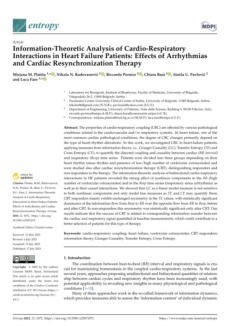

Authors: Beibei Dong, Yuanyuan Bai, Qi Jia, Lin Su, Xinyue
Zhang, Shiquan Wang, Zongping Fang
Stroke is a major health concern and a leading cause of
mortality and morbidity. The authors and other groups
have documented that hyperbaric oxygen
preconditioning could significantly alleviate neuronal
damage in ischemia-reperfusion models through various
mechanisms. However, they found that some of the
subjects did not benefit from preconditioning with
hyperbaric oxygen. The preconditioning phenomenon is
similar to vaccination, in which the endogenous survival
system is activated to fight against further injuries.


Authors: Yulianus Sudarman, H. Melangka
Early initiation of diving is a technique that is often carried
out by fishermen in Batangono village using traditional
methods without tools, from their knowledge of diving is
obtained from generation to generation, so the
consequences of diving activities can have an impact on
health, and the attitude shown in the barotrauma incident
is also still lacking in handling. The aim of the research is to
determine the relationship between knowledge,attitudes,
and the incidence of barotrauma in the community of
Batangono Village, Buko District, Banggai Islands
Regency.


Authors: Lin ZC, Bennett MH, Hawkins GC, Azzopardi CP,
Feldmeier J, Smee R, Milross C
Cancer is a significant global health issue. Radiotherapy is
a treatment modality for many malignancies, and about
50% of people having radiotherapy will be long-term
survivors. Some will experience late radiation tissue injury
(LRTI), developing months or years following
radiotherapy. Hyperbaric oxygen therapy (HBOT) has
been suggested as a treatment for LRTI based on the
ability to improve the blood supply to these tissues. It is
postulated that HBOT may result in both healing of tissues
and the prevention of complications following
surgery and radiotherapy.


Authors: Jan Risberg, Pieter-Jan van Ooij, Olav Sande
Eftedal
There is an increasing interest in ‘transfer under pressure’
(TUP) decompression in commercial diving, which bridges
traditional surface-oriented diving and saturation diving. In
TUP diving, the diver is surfaced in a closed bell and
transferred isobarically to a pressure chamber for final
decompression to surface pressure.
Tables for air diving and air and oxygen decompression
have been compared for total decompression time,
oxygen breathing time, as well as high and low gradient
factors (GF high and low). These have been considered
surrogate outcome measures of decompression sickness.


Authors: Nicole YE Wong, Hanna van Waart, Jamie W
Sleigh, Simon J Mitchell, Xavier CE Vrijdag
Hypoxia can cause central nervous system dysfunction
and injury. Hypoxia is a particular risk during rebreather
diving. Given its subtle symptom profile and catastrophic
consequences, there is a need for reliable hypoxia
monitoring. Electroencephalography (EEG) is being
investigated as a real-time monitor for multiple diving
problems related to inspired gas, including hypoxia.
A systematic literature search identified articles
investigating the relationship between EEG changes and
acute cerebral hypoxia in healthy adults. The quality of
clinical evidence was assessed using the Newcastle-
Ottawa scale.
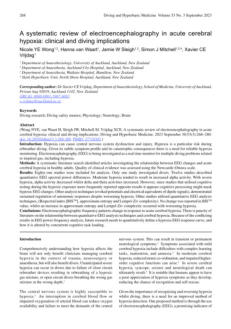

Authors: Kartini
Oxygen is a chemical substance needed by patients for
treatment and/or the healing process. To maintain the
availability of oxygen so that it is always in an effective and
efficient amount, always ensure a safe condition.
However, in practice, there are sometimes problems
related to availability in the warehouse, such as vacancies.
This is a descriptive, qualitative research study.

Authors:
Pei Wang, Xiao-Yan Wang, Chang-Feng Man, Dan-Dan
Gong, and Yu Fan
In this article, the authors summarize that hyperbaric
oxygen therapy regulates the tumor microenvironment
through various pathways, such as improving tumor
hypoxia,targeting hypoxia-inducing factors, and
generating reactive oxygen species. The changes in the
tumor microenvironment ultimately affect the curative
effect of immunotherapy.
Therefore, hyperbaric oxygen can influence
immunotherapy by regulating the tumor
microenvironment, providing a direction for the future
development of immunotherapy.



Authors: Kevin L. Webb, Mich
This work uses a mathematical model that couples
pulmonary oxygen uptake with systemic oxygen utilization
under conditions of high metabolic demand to investigate
the effect of hemoglobin- oxygen affinity on oxygen
uptake and utilization (VO2 max) max as a function of
altitude.




Authors:
Damian M. Bailey, Anthony R. Bain, Ryan L. Hoiland, Otto
F. Barak, Ivan Drvis, Benjamin S. Stacey, Angelo Iannetelli,
Gareth W. Davison, Rasmus H. Dahl, Ronan M.G. Berg,
David B. MacLeod, Zeljko Dujic, & Philip N. Ainslie
Voluntary asphyxia induced by apnea in competitive
breath hold (BH) divers affords a unique opportunity to
examine integrated mechanisms underlying the
preservation of cerebral bioenergetic function.
This study examined to what extent physiological extremes
of oxygen (O2) demand and carbon dioxide (CO2 )
production impact redox homeostasis and corresponding
red blood cell (RBC)-mediated cerebral vasodilation.


Authors: Sotiris P. Evgenidis, Thodoris D. Karapantsios
I-VED, a new tool developed under a European Space
Agency project using EU-patented technology, detects air
bubbles in humans to prevent decompression sickness. It
has been tested in vitro and is being prepared for in vivo
testing.
Using 3D simulations, researchers studied bubble
behaviour in human arteries and found consistent
patterns despite changes in artery size. These findings will
help optimize I-VED for real-world usage.


Authors: Philipp Herold, and Daniel Weh
This study examined the accuracy of Continuous Glucose
Monitoring (CGM) systems under hyperbaric conditions. It
is suggested that diabetic divers can use CGM monitors to
manage their glucose levels and prevent hypoglycemic
events during dives. Dive guidelines could include the use
of CGM monitors to enhance safety. The study supports
the hypothesis that increased pressure and saltwater do
not affect CGM functionality, recommending further
research with more diverse sampling and detailed glucose
measurement methods.


Authors: Natasa Z. Misic, Mirko Ostojic, Sasa Cvetkovic,
Petar Miodragovic, Zdravko Anicic, Anita Kovacic
Popovic, & Doede Stefanovic
The authors analyzed the wavelet spectral characteristics
of respiratory muscles (scalenus, parasternal intercostal,
and rectus abdominis) and a locomotor muscle
(brachioradialis) in the time-frequency domain during
voluntary breath-holding in twelve healthy participants.
This study suggests that analyzing muscle activity during
breath-holding can achieve non-invasive assessment of
muscle oxygenation and physical fitness.


Authors:
Brice Loddé, Marie-Agnès Giroux-Metges, Hubert Galinat,
Hèlène Kerspern, Richard Pougnet, Philippe Saliou,
François Guerrero, and Pierre Lafère
This study investigated the relationship between reduced
lung diffusion capacity (DLCO) and the physiological
responses to diving in 15 professional divers. Several
health parameters were measured. The results showed
that divers with reduced DLCO had a delayed response to
vascular gas embolism and higher levels of certain
biomarkers compared to the control group. Although
decompression sickness was not observed, the results
suggest a potentially increased risk for divers with lower
DLCO. Further research is necessary to confirm these
findings.


Author: Marten Silvanus
This study aims to improve decompression algorithms to
boost diver safety and reduce decompression sickness by
using probabilistic modeling. It also considers adjusting
the oxygen regimen for inside attendants in long-duration
hyperbaric oxygen therapy to enable safer and quicker
decompression.


Authors: Kubra Canarslan-Demir, Kubra Ozgok-Kangal,
Samet Kilic, Hakan Genc
The authors aimed to observe the effect of diving on
hearing function by comparing the audiometry of
experienced divers with that of a non-diving control
group. They also compared the hearing function of divers
based on the number of years of diving and the number
of dives.
In conclusion, there was no evidence of a worsening
effect of diving on hearing function in experienced divers.
This is attributed to an increase in awareness of
occupational safety, modern technology, protective
measures, and more conservative dive profiles.


Author: Figen Aydin
This paper documents the indications, outcomes,
complications, and difficulties encountered during HBOT
in a large cohort of pediatric patients and compares them
with adult data in the literature. Out of the 329 pediatric
patients, 254 completed treatment as planned, and 218
achieved treatment goals without complications. Two
patients treated for carbon monoxide poisoning had
neurological sequelae. Additionally, one patient with limb
ischemia underwent amputation.


Authors: Abraham L Querido, Chiel F Ebbelaar, Thijs T
Wingelaar
This review addresses safety issues related to diving while
taking psychotropic medication, noting the limited
research and unclear reasons why divers on these
medications continue to dive. The mechanisms of how
these drugs work under increased pressure are not well
understood. Currently, fitness-to-dive guidelines are based
on limited evidence and expert opinions. The review
emphasizes the need for evidence-based approaches to
improve diver safety and patient care, providing insights
for diving physicians assessing divers taking psychotropic
drugs.


Authors:
Matteo Paganini, Giuseppe Cantarella, Danilo Cialoni, Ezio
Giuffrè, & Gerardo Bosco
As a diagnostic tool, ultrasound was first developed to
explore anatomic areas in which standard radiography
had limited applications and accuracy, such as the
abdomen, the heart, arteries, and veins. Surprisingly,
ultrasound has become a fundamental tool for clinicians.
After creating portable apparatuses, point-of-care
ultrasound (POCUS) has implemented the traditional
physical exam so that real-time insonation and
interpretation allow the clinician to confirm or reject
diagnostic hypotheses at the bedside.








Authors:
Jie-Fu Fan, Yang-Kai Wang, Min Liu, Guang-Sheng Liu,
Tian-Jiao Min, Rui-Yong Chen, & Ying He
This study investigated the effects of irradiation on
decompression sickness (DCS) and the underlying
mechanisms. It allowed the authors to witness whether
irradiation increases the incidence and severity of DCS,
particularly focusing on lung injury and related biological
pathways. It details the research's methodology, results,
and conclusions, highlighting the exacerbation of DCS
outcomes due to irradiation and the involvement of the
angiotensin system, oxidative stress, and the PI3K/AKT
signaling pathway.


Authors:
Meng-Meng Shi, Yun-Tian Chen, Xiao-Dan Wang, Yun-
Feng Zhang, Ting Cheng, Hui Chen, Feng Sun, Hong
Bao, Rong Chen, Wei-Ning Xiong, Yuan-Lin Song, Qing-
Yun Li, and Jie-Ming Qu
The authors of this study explored the efficacy of
hydrogen/oxygen mixed inhalation therapy in aiding the
recovery of patients infected with the Omicron variant of
SARS-CoV-2. It demonstrates that hydrogen/oxygen
therapy could be beneficial in reducing the duration of
viral shedding, improving the negative conversion rate of
the virus, decreasing IL-6 levels, increasing lymphocyte
count, and resolving pulmonary lesions, thereby
suggesting it as a potential adjuvant treatment for COVID-
19 patients.


Author: Christopher R. Kovacs
This document review and analyze the stress response
and the role of panic in scuba diving, with the aim of
providing recommendations to understand and manage
these factors to enhance the safety of scuba diving across
various applications.


Author:
Koichi Kurihara, Azusa Kikukawa, and Asao Kobayashi
This report discusses a study on the effects of postural
changes on cerebral oxygenation, using reflectance near-
infrared spectroscopy (NIRS) and a new clinical tissue
oxygenation monitor to provide insights into how
different body positions, such as head-up tilt (HUT) and
head-down tilt (HDT), affect cerebral oxygenation levels,
as measured by changes in oxyhemoglobin,
deoxyhemoglobin, and the Tissue Oxygenation Index
(TOI). It also highlights the variability in measurements
between the left and right sides of the forehead,
suggesting potential influences of cognitive or emotional
factors.



Authors: Arian Azarang, S. Lesley Blogg, Joshua Currens,
Rachel M. Lance, Richard E. Moon, Peter
Lindholm, Virginie Papadopoulou
This paper describes the development and application of
a graphical user interface (GUI) that utilizes automatic
speech recognition technology to separate human
speech from old Doppler ultrasound audio recordings,
often captured on cassettes in one-channel audio with a
superimposed human speech describing the experiment.
This tool is intended to aid in the processing and analysis
of historical decompression research data, which allows
scientists to reuse previously collected datasets and is
relevant for preventing decompression sickness.
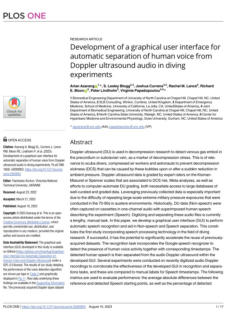

Authors: Antoinette Houtkooper, Thijs T Wingelaar, Edwin
L Endert, Pieter-Jan AM van Ooij
This study investigates the long-term health effects of living
aboard submarines on veteran submariners to compare
the health status of these submariners with the general
population and to analyze whether factors such as rank,
time at sea, and time in service influence their health
outcomes. A summary of the methodology, results, and
conclusions of the research is provided.


Authors: Stanisław Skrzynski, Piotr Siermontowski
This study discusses guidelines and methods to analyze
and compare saturation diving procedures, explicitly
focusing on their application within the Polish Baltic shelf
to identify suitable technologies for the region by
reviewing existing procedures, discussing boundary
conditions, and examining development trends.
Additionally, it highlights the alignment of past Polish
saturation diving conditions with current leading
technologies.
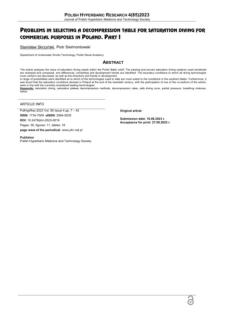

Authors: Sven De Ridder, Nathalie Pattyn, Xavier Neyt,
Peter Germonpré
This document provides guidelines and recommendations
for optimizing gradient factor (GF) settings on the
Shearwater Perdix dive computer for Belgian military divers
by discussing the operational constraints of using the
default GF settings and presenting findings on how to
adjust these settings to align more closely with established
decompression tables (DCIEM and USN) to enhance
safety. The conclusion advises against using the default
settings and suggests alternative symmetrical GF settings
due to software limitations.



Click on the octopus
to return to the top
of the page

Click here




Author: Stanisław Skrzynski
This article discusses the implementation of saturation
diving technology in Poland, focusing on the emerging
offshore mining industry. The technology was developed
by the Department of Diving Equipment and
Technology of Underwater Works, and has become an
everyday occurrence in the Polish economic zone of the
Baltic Sea since 1995. The article highlights the difficulties
faced during economic instability and the technical and
organizational conditions.


14 - Problems in Selecting a Decompression Table for Saturation
Diving for Commercial Purposes in Poland. Part III C: Technical
and Organisational Issues of the Implementation of Saturation
Diving in Poland from the 1990s Onward. Part 3



15 - The use of dive computers in forensic investigations of fatal
breath-hold diving accidents: a case study
Authors: Hazem M. Sherif, Younis M. Albalooshi,
Ahmad Al Hashemi, Islam Feteaha,
Farha H. Ismail, Mamdouh Kamal Zaki
Freediving, or breath-hold diving, relies on how long
divers can hold their breath underwater. Unlike scuba
diving, it doesn’t require training or licenses, which can
lead to unawareness of risks. This paper details a case
where coastguards found a diver's body due to a shallow
water blackout. Dive computers can provide crucial data
in investigations of such fatalities, yet they are often
overlooked. It's vital to gather all diving information before
drawing conclusions, especially to support grieving
families.












